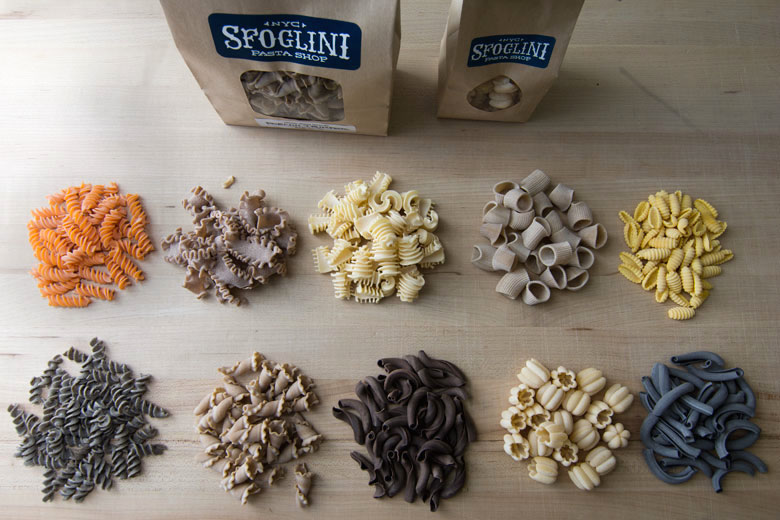Oftentimes pasta is the carb-vehicle for your favorite ingredients — a lamb ragu, or a bright, summery mix of produce. But what happens when you start incorporating the seasons into the pasta?
Enter Sfoglini, the Brookyln-based pasta maker that’s been mixing seasonal ingredients like beets, porcini mushrooms, basil and even nettles into pasta dough, churning out bright red fusilli, or deep green radiators.
The idea started with basil pasta, and then grew. “Italian cooking is all about using the ingredients around you,” Scott Ketchum, co-founder, says. So why not use them in the pastas, not just the dishes?
Operating out of the old Pfizer-turned-food incubator space on Flushing, Sfoglini constantly experiments with new ingredients. If seasonal produce can be juiced, the juice replaces some of the water in the pasta dough. Greens are blanched and then shocked to maintain their bright color, while others are dried and ground up to incorporate into the flour. Here, a primer on the best shapes — and the accompanying sauces — of their seasonal pastas.

The Pasta That Does Everything: Fusilli
“Fusilli is pretty flexible,” Scott Ketchum says. When making pastas, you have to think about the drying pastas, and if the shape isn’t durable enough, it’ll crumble. Fusilli is one of the few shapes — reginetti and radiatore are the other two — that can endure many manipulations in ingredients without falling apart. “We can do about anything with it,” Ketchum says.
The result? Everything from chili pepper fusilli (for extra bite) to beet fusilli to squid ink. Shape-wise, anything that has a lot of grooves will hold a lot of sauce. “You have things like fusilli, radiatore, reginetti, they can hold a bolognese or tomato sauce, so you’re getting a better bite every time.”

The Macaroni Replacement: Spaccatelli
These rolled-up tubes of pasta are pretty much replacement zitis or macaronis, and thanks to the folds any vegetable or meat sauce would get wrapped up nicely. When it comes to the flavors, however, things can get more technical. On the left, there’s cocoa spaccatelli — think deeply bitter, rather than sweet. “We found a lot of people get confused with cocoa,” Gonzalez says. “They think cocoa powder, instead of chocolate. But if you think of it as a slightly bitter, chocolate with squash, sage, and brown butter, that’s great.” Conversely, the briny squid ink version, right, pairs with buttery, seafood toppings.

The Soup Cup: Zucca
More-so an adorable shape than a flavored pasta, this type of pasta is shaped like an open pumpkin, meaning prime sauce-scooping action. “If you have a thinner sauce, this will capture that,” Ketchum says. Slightly more difficult to make — they can shatter during the drying process — the resulting pasta works better with small chunks of cubed meat or vegetables, with thinner sauces. One Sfoglini recipe calls for diced bacon and peas. “Anything that’s got a pocket or a curve, it’s all ripe opportunity for sauce to go in there,” Gonzalez says. “And if you dice eggplant, I love it when eggplant happens to fall into the pasta, and you get the complete, perfect bite.”

The Everything Pasta: Malloreddus
This classic Sardinian pasta, with a hint of earthiness thanks to additional saffron, is typically served with a tomato sauce, mint, and Pecorino cheese. Still, the shallow cups, small ridges, and the pasta’s chewy, thick texture means it’s paired best with anything that can stand up to its heft. “I’ve had it under some beef stew before,” Gonzalez says, while Sfoglini recommends serving it with garlic, fennel, and a healthy dose of Pecorino.

The Trumpet: Campanelle
Like the zucca, the flower-shaped campanelle has a small opening for sauce and bits of vegetable to fill up. Like fusilli, however, the ridges allows sauce to cling on, which means this is the perfect in-between pasta shape—great with a light pasta salad, in a thick sauce, or in a casserole. “With trumpet you could have a bolognese, too, but with a straight tomato sauce it’s great,” Gonzalez says. “Tomato sauce just so happily falls in there.”
Sfoglini’s campanelle pastas also come in seasonal flavors — a rye, porcini, and even if you’re lucky garlic scapes. And, while Sfoglini does hand out recipe cards to accompany their signature creations, Gonzalez notes that the best way to truly taste the pasta is to go simple. “You want to think about the flavor first, then shape,” Gonzalez says. “And if you’re ever confused with pasta, go with butter and cheese. That was you can really taste it.”
Photo credit: Jessica Chou





